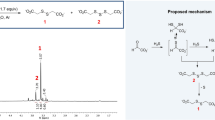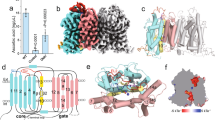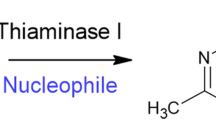Abstract
KNOWLEDGE of the detailed action of vitamin B1 in Nature has advanced farther than in the case of any other vitamins with the possible exception of riboflavin, and nicotinic acid; even in the case of these, detailed knowledge has come to hand more recently. This is not only due to the striking advances in the pure chemistry but also to the fortunate circumstance that it was the first vitamin in which specific action in vitro upon an animal tissue was demonstrated1. Since its action is so intimately bound up with a fundamental stage in the degradation of carbohydrate, it justifies in a way the conception originally lying behind the use of the word ‘vitamine’ by Funk. Useful as the new terms for this vitamin ‘aneurin’ and ‘thiamin’ undoubtedly are, it seems a pity to lose sight of the idea of the “amine essential for life”, because in a way this is very nearly true. Formation of carbon dioxide depends more upon this factor than upon any other.
This is a preview of subscription content, access via your institution
Access options
Subscribe to this journal
Receive 51 print issues and online access
$199.00 per year
only $3.90 per issue
Buy this article
- Purchase on Springer Link
- Instant access to full article PDF
Prices may be subject to local taxes which are calculated during checkout
Similar content being viewed by others
References
Gavrilescu, Meikeljohn, Passmore and Peters . Proc. Roy. Soc., B, 110. 431 (1932).
Kinnersley and Peters, Biochem. J., 22, 419 (1928).
See especially Pyke, J. Soc. Chem. and. Ind., 58, 338 (1939).
Houston, Kon and Thompson, Soc. Chem. and Ind., Proc. Biochem. Soc., July 1939.
Weijland and Tauber, J. Amer. Chem. Soc., 60, 2263 (1938); Weil-Malherbe, Biochem. J., 34, 980 (1940). Stocken (unpublished).
For many references see recent lecture.J. Soc. Chem. and Ind., 59, 373 (1940).
Banga, Ochoa and Peters, Biochem. J., 33, 1109 and 1980 (1939).
Ochoa (unpublished).
Lipton and Elvehjem, also Lipmann-Sympos . Quant. Biology Cold Spring Harbor (1940) Weil-Malherbe, Biochem. J., 33, 1997 (1940).
Ochoa and Long (independently); unpublished.
Krebs and Eggleston, Biochem. J., 34, 442 (1940).
Ochoa, NATURE, 146, 267 (1940).
Cori, Colowick and Cori, J. Biol. Chem., 133, 359 (1940).
Author information
Authors and Affiliations
Rights and permissions
About this article
Cite this article
PETERS, R. Cocarboxylase. Nature 146, 387–391 (1940). https://doi.org/10.1038/146387a0
Issue Date:
DOI: https://doi.org/10.1038/146387a0
This article is cited by
-
Carbon Dioxide Assimilation in Heterotrophic Organisms
Nature (1941)
Comments
By submitting a comment you agree to abide by our Terms and Community Guidelines. If you find something abusive or that does not comply with our terms or guidelines please flag it as inappropriate.



